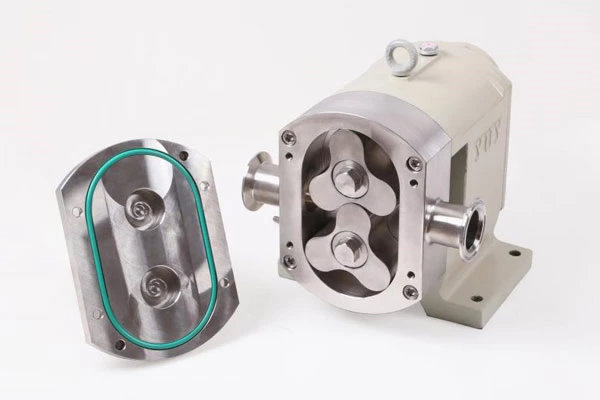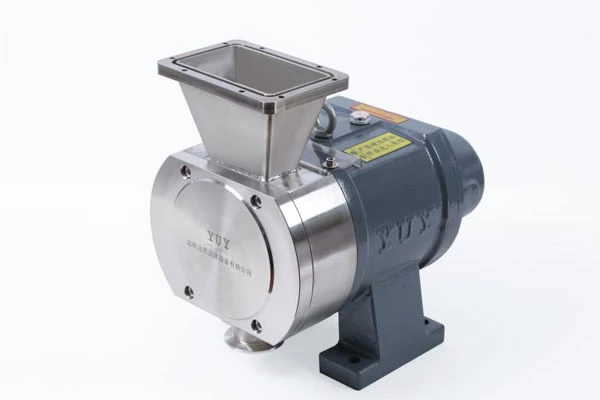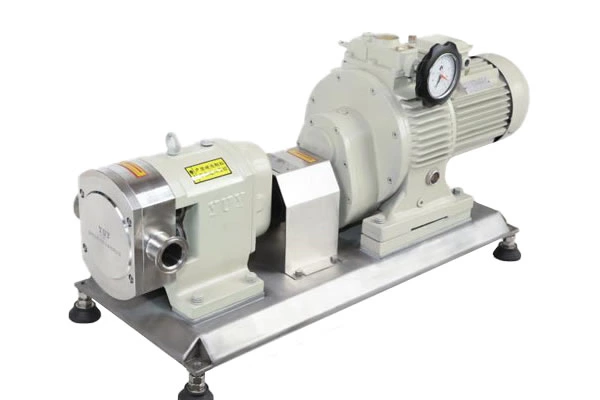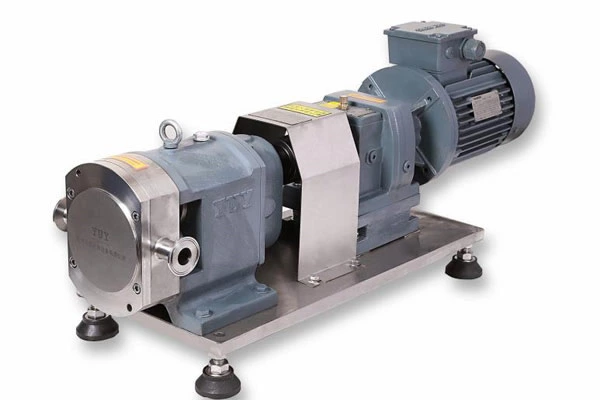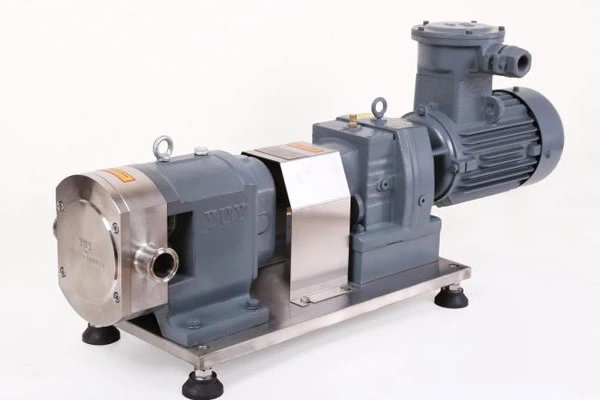Fault Analysis And Troubleshooting Methods For Sanitary Rotary Cam Pump
Sanitary Rotary Lobe Pump is an important component that uses a pair of involute gears with the same parameters and structure to roll and mesh with each other, raising the low-pressure oil in the oil tank to high-pressure oil that can do work. It is a power device that converts the mechanical energy of an engine into hydraulic energy. The Dongfanghong-75 tractor and Dongfanghong-60, 70T bulldozer mechanisms use CB46 gear pumps. The Dongfanghong-802/802K tractor and Dongfanghong-802KT bulldozer use CBN-E450 or CBTI-E550 gear pumps, which have high flow rates and good reliability. The following faults are prone to occur during its use.
1. Internal parts of the oil pump are worn out
Wear of internal parts of the oil pump can cause internal leakage. The leakage area between the floating shaft sleeve and the gear end face is large, which is the main part causing internal leakage. This part of the leakage accounts for about 50% to 70% of the total internal leakage. The volumetric efficiency of gear pumps with wear and leakage decreases, and the output power of the oil pump is significantly lower than the input power. All of its losses are converted into heat energy, which can cause the oil pump to overheat. If the joint plane is pressed tightly, the floating shaft sleeve may experience slight movement during operation, causing wear and tear, resulting in slow or impossible lifting of the agricultural tool. Such floating shaft sleeves must be replaced or repaired.
2. Wear and tear of oil pump housing
The main issue is the wear of the floating shaft sleeve hole (the normal clearance between the gear shaft and the shaft sleeve is 0.09-0.175mm, with a maximum of 0.20mm). Gear operation is affected by pressure oil, and the gear tip is close to the oil pump housing, causing wear on the low-pressure chamber of the pump body. Another type of wear is the circular wear of the working surface inside the shell, which is mainly caused by the incomplete addition of oil, so it is necessary to add oil without impurities.
3. Oil seal wear, rubber seal aging
The rubber oil seal of the unloading plate ages and deteriorates, losing its elasticity, and losing its sealing and isolation effect on the high-pressure oil chamber and low-pressure oil chamber. This will cause the oil pressure in the high-pressure oil chamber to flow into the low-pressure oil chamber, known as "internal leakage", which reduces the working pressure and flow rate of the oil pump. The normal working pressure of CB46 gear pump is 100-110kg/square centimeter, the normal oil delivery rate is 46L/min, and the standard unloading rubber oil seal is 57 × 43. Self tightening oil seal is a skeleton type oil seal of PG25 × 42 × 10. If it is damaged or fails for a long time, air will be sucked into the oil pump through the gap between the oil seal and the main shaft neck or from the joint between the oil inlet disc and the oil pump housing, and enter the oil tank through the return pipe, generating a large number of bubbles in the oil tank. It will cause a decrease in oil in the fuel tank and an increase in oil in the engine oil sump, resulting in slow or impossible lifting of agricultural tools. The oil seal must be replaced in order to troubleshoot this issue.
4. Insufficient oil supply or no oil pressure of the oil pump
Phenomenon: The working device lifts slowly, shaking or unable to lift during lifting; There are bubbles in the fuel tank or oil pipe; When lifting, the hydraulic system emits a "chirp, chirp" sound; When the tractor is first started, the working device can be raised. After working for a period of time, if the oil temperature rises, the lifting will be slow or unable to be raised; It can be lifted under light load, but not under heavy load.
Reason for malfunction:
(1) The oil level in the hydraulic oil tank is too low;
(2) Not using hydraulic oil according to the season;
(3) The oil inlet pipe is severely blocked by dirt;
(4) The oil seal of the driving gear of the oil pump is damaged, and air enters the hydraulic system;
(5) The O-ring seal of the oil pump inlet and outlet joint or bend joint is damaged, the fastening bolts of the bend joint or the nuts of the inlet and outlet oil pipes are not tightened, and air enters the hydraulic system;
(6) Internal leakage of oil pump and aging of sealing ring;
(7) Wear or scratches on the oil pump end face or the main and driven gear shaft sleeve end face, and the unevenness of the two shaft sleeve end faces exceeds the tolerance;
(8) Internal leakage caused by incorrect assembly of internal components in the oil pump;
(9) The installation of a "left-handed" and "right-handed" oil pump caused damage to the skeleton oil seal;
(10) The hydraulic oil is too dirty.
Exclusion method:
(1) Add or replace engine oil of the required grade according to the season to the specified oil level. Remove foreign objects from the oil pipe and tighten the bolts or nuts at the joint;
(2) Replace aging or damaged skeleton oil seals or "O" - shaped sealing gaskets;
(3) Replace the worn sanitary rotary cam pump or oil pump shaft sleeve, and if the wear is slight, grind the end face flat on a flat plate. The allowable error for its unevenness is 0.03mm; The end face of the upper shaft sleeve is lower than the upper plane of the pump body (normal value is lower than 2.5-2.6mm). If it exceeds the tolerance, a 0.1-0.2mm copper sheet should be added to the lower shaft sleeve to compensate. When installing, it should be fitted onto the rear axle sleeve;
(4) The unloading plate and sealing ring must be installed in the oil inlet chamber for the two shaft sleeves to maintain balance. The unloading plate sealing ring should have a preload of 0.5mm;
(5) The guiding steel wire elasticity should be able to simultaneously twist the upper and lower shaft sleeves towards the direction of rotation of the driven gear by a small angle, so that the machining planes of the two shaft sleeves of the main and driven gears are tightly fitted;
(6) The unloading groove on the shaft sleeve must be installed on one side of the low-pressure chamber to eliminate harmful dead volume generated during gear meshing;
(7) Before pressing in the self tightening oil seal, a layer of lubricating oil should be applied to its surface, and attention should be paid to facing the oil blocking edge towards the front cover and not installing it backwards;
(8) The "right-handed" pump cannot be installed on the "left-handed" machine, otherwise it will damage the skeleton oil seal;
(9) Before installing the pump cover, a small amount of engine oil should be poured into the pump casing and the meshing gear should be manually rotated;
(10) Before installing the oil pump cover and tightening the bolts, the gap between the pump cover and the pump body should be checked to ensure it is between 0.3-0.6mm. If the gap is too small, the large sealing ring and pressure relief component should be replaced. After the hydraulic oil pump is installed, it should rotate flexibly without any jamming phenomenon.
